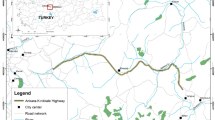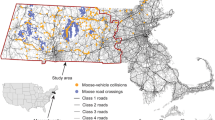Abstract
Despite the fact that all highways in Hungary are built with fencing, there are still 5 % of traffic accidents that involve wildlife. Therefore, this study focused on the incidence of collisions along fenced roads. Wildlife–vehicle collision (WVC) hotspots were mapped, and the spatial frequencies were analysed with Poisson regression. In general, most WVCs and almost all of the roe deer fatalities occurred at highway intersections, or at interchanges. Red fox casualties also occurred at interchanges as well as at passages. Wild boar fatalities were not particularly frequent at interchanges but were recorded near railways that are parallel to highways; otter–vehicle collision hotspots were found near their habitats and migration corridors such as streams. For otter, badger and wild boar, we were able to examine the role of local population density; most WVCs happened in areas of high population density. The badger model predicted that badger kills were more likely where the fence was not buried in the soil. Most WVCs occur at interchanges because wildlife enters the right-of-way (ROW) at fence ends; or it enters at a fence gap and runs along the outside of fence and becomes funnelled onto the ROW at the interchanges. Interruption in the continuity and linearity are important factors in both cases. We concluded that the number of WVCs can be reduced significantly if animals were prevented from entering highway interchanges and proposals for mitigation were made. We also propose a tool to assist in alleviating WVCs, by mapping them in Google Maps and integrating hotspots into a car navigation system.





Similar content being viewed by others
References
Allen RE, McCullough DR (1976) Deer–car accidents in southern Michigan. J Wildl Manag 40:317–325
Bashore TL, Tzilkowski WM, Bellis ED (1985) Analysis of deer–vehicle collision sites in Pennsylvania. J Wildl Manag 49:769–774
Belant JL, Seamans TW, Dwyer CP (1998) Cattle guards reduce white-tailed deer crossings through fence openings. Int J Pest Manag 44(4):247–249
Bihari Z, Csorba G, Heltai M (eds) (2007) Magyarország emlőseinek atlasza. Kossuth Kiadó, Budapest
Bissonette JA, Hammer M (2000) Effectiveness of earthen ramps in reducing big game highway mortality in Utah: final report. Utah Coop Fish Wildl Res Unit Rep Ser 1:1–29
Bomford M, O’Brien PH (1990) Sonic deterrents in animal damage control: a review of device tests and effectiveness. Wildl Soc B 18:411–422
Burnham KP, Anderson DR (2002) Model selection and multimodal inference: a practical information-theoretic approach, 2nd edn. Springer-Verlag, New York
Colino-Rabanal VJ, Lizana M, Peris SJ (2010) Factors influencing wolf Canis lupus roadkills in Northwest Spain. Eur J Wildl Res 57(3):399–409
Clevenger AP, Waltho N (2000) Factors influencing the effectiveness of wildlife underpasses in Banff National Park, Alberta, Canada. Conserv Biol 14:47–56
Clevenger AP, Chruszcz B, Gunson KE (2001) Highway mitigation fencing reduces wildlife–vehicle collisions. Wildl Soc B 29:646–653
Clevenger AP, Chruszcz B, Gunson KE (2003) Spatial patterns and factors influencing small vertebrate fauna vehicle-kill aggregations. Biol Conserv 109:15–26
Curtis PD, Fitzgerald C, Richmond ME (1995) Evaluation of the Yard Gard ultrasonic yard protector for repelling white-tailed deer. East Wildl Damage Control Conf 7:172–176
Csányi S, Lehoczki R, Sonkoly K (Eds.) (2010) Vadgazdálkodási Adattár - 2009/2010. vadászati év. Országos Vadgazdálkodási Adattár, Gödöllő
Cserkész T, Farkas J, Ottlecz B (2012) Complex wildlife–vehicle collision research on the SMMC’s highway network. Report to Hungarian State Motorway Management Company. Eötvös University Road Ecological Work Group, Budapest
Dodd CK, Barichivich WJ, Smith LL (2004) Effectiveness of a barrier wall and culverts in reducing wildlife mortality on a heavily traveled highway in Florida. Biol Conserv 118:619–631
Dodd NL, Gagnon JW, Boe S, Manzo A, Schweinsburg RE (2007) Evaluation of measures to minimize wildlife–vehicle collisions and maintain wildlife permeability across highways—State Route 260, Arizona, USA. Final project 540 report (2002–2006). Arizona Transportation Research Center, Arizona Department of Transportation, Phoenix
Feldhamer GA, Gates JE, Harman DM, Loranger AJ, Dixon KR (1986) Effects of interstate highway fencing on white-tailed deer activity. J Wildl Manag 50:497–503
Finder RA, Roseberry JL, Woolf A (1999) Site and landscape conditions at white-tailed deer/vehicle collision locations in Illinois. Landsc Urban Plan 44:77–85
Foster ML, Humphrey SR (1995) Use of highway underpasses by Florida panthers and other wildlife. Wildl Soc B 23:95–100
Found R, Boyce MS (2011) Predicting deer–vehicle collisions in an urban area. J Environ Manage 92:2486–2493
Gera P (2007) Az “Alapítvány a Vidrákért” szervezet által 1995 és 2007 között koordinált magyarországi vidravédelmi programok összefoglaló dolgozata. Alapítvány a Vidrákért
Glista DJ, DeVault TL, DeWoody JA (2009) A review of mitigation measures for reducing wildlife mortality on roadways. Landsc Urban Plan 91:1–7
Grilo C, Bissonette JA, Santos-Reis M (2009) Spatial-temporal patterns in Mediterranean carnivore casualties: consequences for mitigation. Biol Conserv 142:301–313
Groot-Bruinderink GWTA, Hazebroek E (1996) Ungulate traffic collisions in Europe. Conserv Biol 10:1059–1067
Gunson KE, Mountrakis G, Quackenbush L (2011) Spatial wildlife–vehicle collision models: a review of current work, and their application to transportation mitigation projects. J Environ Manage 92(4):1074–1082
Hothorn T, Brandl R, Müller J (2012) Large-scale model-based assessment of deer–vehicle collision risk. PLoS One 7(2):e29510
Hubbard MW, Danielson BJ, Schmitz RA (2000) Factors influencing the location of deer–vehicle accidents in Iowa. J Wildl Manag 64:707–713
Huijser MP, McGowen P, Fuller J, Hardy A, Kociolek A, Clevenger AP, Smith D, Ament R (2008) Wildlife–vehicle collision reduction study. Report to Congress. U.S. Department of Transportation, Federal Highway Administration, Washington
Iuell B, Bekker GJ et al (eds) (2003) COST 341—wildlife and traffic: a European handbook for identifying conflicts and designing solutions. KNNV Publishers, Utrecht
Jancke S, Giere P (2011) Patterns of otter Lutra lutra road mortality in a landscape abundant in lakes. Eur J Wildl Res 57(2):373–381
Langbein J, Putman R, Pokorny B (2011) Traffic collisions involving deer and other ungulates in Europe and available measures for mitigation. In: Putman R, Apollonio M, Andersen R (eds). Ungulate management in Europe: problems and practices. Cambridge University Press, pp. 215–259
Lanszki J (2009) Vadon élő vidrák Magyarországon. Natura Somogyiensis 14. Somogy Megyei Múzeumok Igazgatósága, Kaposvár
Madsen AB, Strandgaard H, Prang A (2002) Factors causing traffic killings of roe deer Capreolus capreolus in Denmark. Wildl Biol 8:55–61
Malo JE, Suarez F, Diez A (2004) Can we mitigate animal–vehicle accidents using predictive models? J Appl Ecol 41:701–710
Mastro LL, Conover MR, Frey SN (2008) Deer–vehicle collision prevention techniques. Hum-Wildl Confl 2:80–92
McCaffery KR (1973) Road kills show trends in Wisconsin deer populations. J Wildl Manage 37:212–216
Néill LO, Veldhuizen T, Jongh AD, Rochford J (2009) Ranging behaviour and socio-biology of Eurasian otters (Lutra lutra) on lowland mesotrophic river systems. Eur J Wildl Res 55(4):363–370
Orlowsky G, Nowak L (2006) Factors influencing mammal roadkills in the agricultural landscape of south-western Poland. Pol J Ecol 54:283–294
Peterson MN, Lopez RR, Sivy NJ, Owen CB, Frank PA, Braden AW (2003) Evaluation of deer exclusion gates in urban areas. Wildl Soc B 31:1198–1204
Philcox CK, Grogan AL, Macdonald DW (1999) Patterns of otter Lutra lutra road mortality in Britain. J Appl Ecol 36(5):748–762
Pojar TM, Prosence RA, Reed DF, Woodward RH (1975) Effectiveness of a lighted, animated deer crossing sign. J Wildl Manag 39:87–91
Puglisi MJ, Lindzey JS, Bellis ED (1974) Factors associated with highway mortality of white-tailed deer. J Wildl Manag 38:799–807
Quantum GIS Development Team (2011) Quantum GIS Geographic Information System. Open Source Geospatial Foundation Project. http://qgis.osgeo.org
Reed DF, Woodard TM, Beck TD (1979) Regional deer–vehicle accident research. Colorado Division of Wildlife, Denver
Rodriguez A, Crema G, Delibes M (1996) Use of non-wildlife passages across a high-speed railway by terrestrial vertebrates. J Appl Ecol 33:1257–1540
Romin LA, Bissonette JA (1996) Deer–vehicle collisions: status of state monitoring activities and mitigation efforts. Wildl Soc B 24:276–283
Seamans TW, Helon AD (2008) Comparison of electrified mats and cattle guards to control white-tailed deer (Odocoileus virginianus) access through fences. Proc Vertebr Pest Conf 23:206–209
Seiler A (2004) Trends and spatial patterns in ungulate–vehicle collisions in Sweden. Wildl Biol 10:301–313
Seiler A (2005) Predicting locations of moose–vehicle collisions in Sweden. J Appl Ecol 42:371–382
Silvy NJ, Sebesta JD (2000) Evaluation of deer guards for Key deer, Big Pine Key. Florida. Florida Department of Transportation, Tallahassee
Singer FJ, Otto DK, Tipton AR, Hable CP (1981) Home range movements and habitat use of wild boar. J Wildl Manag 45:343–353
StatSoft Inc. (2007) STATISTICA (data analysis software system), version 8.0. www.statsoft.com
Stout RJ, Stedman RC, Decker DJ, Knuth BA (1993) Perceptions of risk from deer-related vehicle accidents: implications for public preferences for deer herd size. Wildl Soc B 21:237–249
Valero E, Picos J, Lago L, Lagos L (2012) GIS methodology for the spatial analysis of wildlife-related traffic accidents. In: IENE 2012 International Conference. Swedish Biodiversity Centre, Berlin-Potsdam, p 206
Ward AL (1982) Mule deer behavior in relation to fencing and underpasses on Interstate 80 in Wyoming. Transp Res Rec 859:8–13
Yanes M, Velasco JM, Suárez F (1995) Permeability of roads and railways to vertebrate: the importance of culverts. Biol Conserv 71:217–222
Acknowledgments
The authors would like to thank the State Motorway Management Company Ltd. for sponsoring this research and their cooperation. In particular, we thank Horváthné Szabó Márta and Sztaskó Edina for their kind help. We are also grateful to the Top-Map Ltd. for the cooperation and the anonymous reviewers for their review and comments, which improved the manuscript considerably.
Author information
Authors and Affiliations
Corresponding author
Additional information
Communicated by C. Gortazar
Rights and permissions
About this article
Cite this article
Cserkész, T., Ottlecz, B., Cserkész-Nagy, Á. et al. Interchange as the main factor determining wildlife–vehicle collision hotspots on the fenced highways: spatial analysis and applications. Eur J Wildl Res 59, 587–597 (2013). https://doi.org/10.1007/s10344-013-0710-2
Received:
Revised:
Accepted:
Published:
Issue Date:
DOI: https://doi.org/10.1007/s10344-013-0710-2




